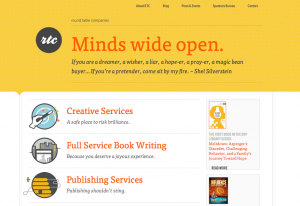

In her 1968 poem ‘The Speed of Darkness’, U.S. poet Muriel Rukeyser wrote, ‘The universe is made of stories, not of atoms’. It’s a lovely image, suggesting life is the sum of the tales we tell. It’s also pretty accurate – we’re hard-wired to rework events into a coherent narrative as we attempt to understand the world. So come with us as we explore how stories can help copywriters communicate with power and personality. Are you sitting comfortably? Then we’ll begin...
The Globe Theatre, Southwark, 1599, about tea time. A group of players assemble on stage, amongst them William Shakespeare, the chap responsible for tonight’s entertainment. Instinctively the groundlings quiet down and the fruit sellers mute their cries. As hush descends, the scene begins:
Now is the winter of our reduced sales forecast, Seasonally adjusted to reflect adverse trading conditions.
An apple core hits Richard III right between the eyes – shot! Another causes the Duke of Clarence to dodge, knocking the ghost of King Henry VI to the ground in a clatter of stage armour. The crowd roars in delight and the attack intensifies, their displeasure all too apparent. This isn’t what they paid to see...
Needless to say, this surreal scene never happened. Then, as now, what theatre-goers want – what we all want – are stories, because stories are an important part of what it is to be human.1 If you’re trying to get through to people, the cant and cliché of business-speak is the biggest turn-off imaginable. You won’t be pelted with rotten fruit but you will be ignored – which in our line of work is just as bad.
From a copywriting perspective stories matter because they’re fun and functional at the same time. Fun because they’re naturally appealing and we’re primed from birth to accept information presented in narrative form; functional because they’re powerful explaining tools that enable us to describe the who, what, where, when, why and how of a subject without seeming to. That’s why stories are important and that’s why every copywriter needs to know when and how to switch into storytelling mode.
What exactly do we mean by ‘stories’?
In this context ‘story’ refers to anything from a short anecdote to a lengthy tale. It probably doesn’t begin ‘Once upon a time’, although brand stories (as we’ll call them) often include features we associate with literary stories. For example, many brand stories feature some sort of hero who struggles with some sort of anti-hero, leading to resolution and a happy ending where everyone goes home wiser. What matters is the effect, not the word count or format. For us, brand stories are about creating engagement. The good news is that shouldn’t be too hard to achieve, as stories are engagement machines par excellence.
Like any good story, a brand story should be clear, compelling and built around a strong central idea. If it isn’t clear then no one will learn anything meaningful, if it isn’t compelling then readers will drift off halfway through and start thinking about lunch, and if it isn’t built around a powerful main theme then your audience will be left wondering what point you’re trying to make.
Another important feature is struggle or difference. Aristotle suggested that, ‘The essence of drama is conflict’. It’s exactly the same here – if a brand story contains even a whiff of tension it’ll become more readable and memorable as a result. It also needs to feel grounded in reality – if a brand story couldn’t possibly be true then it’s fantasy, not copy. The trick is to use a story vivid enough to embed itself in the readers’ imagination, yet real enough to touch on or illuminate some relevant truth.
Of course stories like this demand the right sort of language; they need to use human words and focus on human themes. That’s the way to establish an emotional connection with your audience, and emotional beats rational every time. Here ‘story’ is almost a synonym for ‘brand’, as the next section explains.
Stories as creation myths
Brand stories are a particularly effective way of explaining an organization’s origins. Consider this example from hyper-successful UK smoothie-maker Innocent. It comes from their company rule book:
In the summer of 1998 when we had developed our first smoothie recipes but were still nervous about giving up our proper jobs, we brought £500 worth of fruit, turned it into smoothies and sold them from a stall at a little music festival in London. We put up a big sign saying ‘Do you think we should give up our jobs to make these smoothies?’ and put out a bin saying ‘YES’ and a bin saying ‘NO’ and asked people to put the empty bottle in the right bin. At the end of the weekend the ‘YES’ bin was full so we went in the next day and resigned.
It’s a modern-day creation myth – only it happens to be true. Don’t you feel instant affection for Innocent’s fruit-loving founders? In 110 words they manage to explain when and how it all began, tell us something about their attitude to life and business, locate themselves culturally and give us a glimpse into their organization’s soul, a notoriously intangible subject that often defies direct description.
Then there’s the story of how Nike co-founder Bill Bowerman poured liquid latex onto his wife’s waffle iron to create a grippy sole for a new trainer he was developing at home. That sounds suspiciously fabricated until we learn that during a house clearance in 2010 Bowerman’s daughter-in-law Melissa, found the actual waffle iron her late father ruined in 1970, and presented it to Nike. It seems Bill really did cook up a load of molten latex in his kitchen before using it to create a high-traction running shoe and – as a welcome by-product – one of the world’s most successful companies.
Now see what you think of this creation myth by John Simmons. It describes a tense moment in the real-life history of Guinness, when Dublin’s civic authorities tried to block the company’s access to the city’s water supply – important stuff for any brewer. Look at the language, in particular the unusual word choices (‘expletives’, ‘sanctify’, ‘girth’) and the wordplay (‘stout gentleman’ – Guinness is of course a stout). Look at the structure, in particular how it begins in the middle of the action (a technique we recommended back in Lesson Three). It’s not what you’d expect from a big corporate, yet the result works wonderfully well and illustrates the difference between a dry history and an engaging brand narrative:
The story starts with the expletives deleted. We don’t need to sanctify the memory of our founder but no one ever recorded the swear words Arthur Guinness flung across the barricades at the gentlemen from the Dublin Corporation in 1775. But fling them he did.
The temptation is to describe Arthur Guinness as a stout gentleman. Well, we make no point about his girth but we do know Arthur Guinness took his time before he came around to brewing porter. When he finally did, it was worth waiting for.
But it was water that did it. The whole history of Guinness is built on water.
Think of that the next time you sink a pint. If Arthur hadn’t made his first stand against the bureaucrats and stood up for his commercial rights we wouldn’t be here now thinking of new ways to fight the Guinness cause.
‘I did a deal, dammit, so let’s stick to it!’
Arthur Guinness stuck to it. It took him twelve years to win his fight for the Dublin water rights, but he won. And that was the first crucial turning point in the story of Guinness.
It takes strength to do it. Not necessarily the girder-lifting strength of a strongman, but the commitment that comes with an inner certainty.
Think about it. Savour it. And lift your glass to Arthur. We owe it to him.
Founding stories like this are effective because they humanize a brand’s beginnings. They describe how one or more spirited individuals overcame adversity to achieve fortune and glory, so they’re about belief, vision and maybe a little drama. In other words, they talk about business in non-business terms. This ability to create emotional resonance is the brand story’s greatest asset. We read and remember because we enjoy. No wonder stories are such effective communication tools.
Every brand has one
Just as every organization has a brand (a point we’ll expand on in the next lesson), so every brand has a story – probably many, many stories. Making a conscious effort to tell these tales in an appropriate way isn’t PR puffery, it’s an effective way for a company to connect with its public and make itself understood, remembered and maybe even liked.
The key point for copywriters is that a well-chosen story gives a brand something worthwhile to say. That’s true for both business-to-business and business-to-consumer communications (often shortened to B2B and B2C). After all, business customers are still human and make buying decisions for emotional as well as rational reasons despite what they might say – stories just help them decide. The lesson is simple: if you’re stuck for an angle, search for a story.
Find, don’t invent
So how do you go about writing a brand story? The short answer is, you don’t. You can’t really create stories like these, you can only uncover them.
To do that you need to dig until you find an anecdote with reader appeal that says something worthwhile about your subject. This digging – the sort of thing journalists do every day – can feel like a thankless task; the only good news is that because you find rather than invent brand stories, if/when you strike lucky, then what you’ve found must be true.
The point is, stories like the Innocent creation myth are unlikely to be just sitting there waiting to be noticed. It’s doubtful that during your first meeting with a client they’ll blurt out something quirky and fascinating about how the business began or how their latest product came to be. By all means ask outright if they’ve anything approaching a suitable story – you might get lucky. However, the chances are you’ll have to do some serious research, which in practice means speaking to lots of people and panning for gold in their replies.
Even that apparently simple process can be fraught with difficulties. If you’re inexperienced or lack clout with the client then getting access to knowledge holders can be hard. Your best bet is to enlist the support of a senior figure. Explain what you’re trying to do, why it matters and how they can help by pointing you in the right direction. Ideally you can use their name to get the attention of hard-to-reach members of staff, perhaps using a subject line like ‘XXXX suggested I get in touch’ for your introductory email. Explain why you need their help and how important their contribution might be. A touch of mild flattery never goes amiss.
Turning descriptions into stories
What do you do if you really can’t find a story to suit your purposes? You do the next best thing, which is to turn a straight description into an intriguing tale. How do you do that? Here’s how.
Consider the following chunk of text borrowed from an imaginary webpage for an imaginary chain of upmarket supermarkets:
We aim to develop our people at every opportunity. We’ve a fantastic track record of helping staff improve their skills through accredited training courses in everything from butchery to baking, produce to personnel, and management to marketing. This creates a breadth and depth of experience that keeps our customers coming back.
It’s the sort of thing you see all the time in the corporate world. The from/to device – repeated three times – gives the piece a decent structure and shows the breadth of the company’s business. It’s perfectly well written, yet we sense a missed opportunity. Surely some or all of it could have been presented in story format for added impact? With that in mind here’s our reworked version:
We do everything we can to help our staff become the best they can be. For example, we made sure Ben Jones in our Oxford store had the opportunity to train as a Master Butcher, which meant he could proudly display his graduation certificate as proof of his expertise, which meant Mrs Lynn Manning decided to buy her meat from us this week instead of her usual butcher, which meant her husband Malcolm had some expertly trimmed pork chops for his dinner, which meant no gristly bits for Musky, their Jack Russell terrier. Sorry, boy!
We’re certainly not suggesting this remix is the solution; instead we’re saying that by making it specific, human-orientated and image-intensive it becomes more story-like, with all the benefits that brings.
It’s the same with this (fictional) paragraph taken from (fictional) MajorMining Corp’s website:
Think about the electronics in your home. The chances are they include metals and minerals mined by us. That includes copper for circuit boards, gold for connectors, and silicates and rare metals used in microelectronics. At MajorMining we locate and refine the raw materials that make modern life possible.
Like the supermarket piece above it’s adequate but underwhelming. And again like the earlier example it can be usefully reworked into something more story-like, in this case by introducing human-interest specifics that show how MajorMining’s products are an unseen part of everyday life:
That call you made to wish your mother Happy Birthday – we found and refined the copper that made it possible. Your train journey to work – zinc from our mine in Canada keeps the engine’s chassis rust-free. Your new laptop? It wouldn’t work without the rare metal palladium from our site in Australia. Your TV and DVD player? Us again. Your kids’ game console, your partner’s tablet device, your car’s electronics...well, you get the idea. We are MajorMining, and what we do makes modern life possible.
Our point is that most organizations’ copy feels flat because it fails to establish any sort of one-to-one connection with its readers. As a result there’s nothing to engage the emotions or fire the imagination. That’s a mistake. Strip away the hoopla and all businesses are just one group of people doing stuff for another group of people – human to human. Put it like that and presenting an organization’s story as a story makes perfect sense. In fact it’s crazy to do anything else.
Read Me: 10 Lessons for Writing Great Copy is co-written by Gyles Lingwood, a Principal Lecturer in Advertising & Design at the University of Lincoln. His creative work has won a number of awards including D&AD, British Interactive Media Association and the US Creativity Awards. Follow him on Twitter @GylesLingwood.
This is an excerpt from Read Me: 10 Lessons for Writing Great Copy by Roger Horberry and Gyles Lingwood. Permission given by the publisher, Laurence King.

![Have Agencies Abused the Term 'Storytelling'? [Interview]](http://53.fs1.hubspotusercontent-na1.net/hubfs/53/00-Blog_Thinkstock_Images/agency-storytelling.png)






